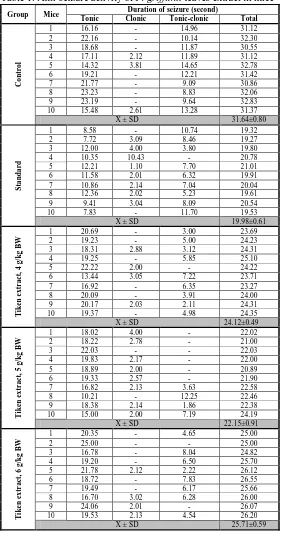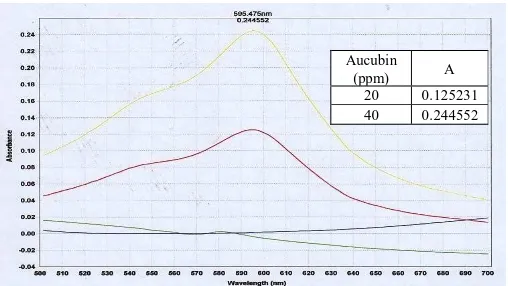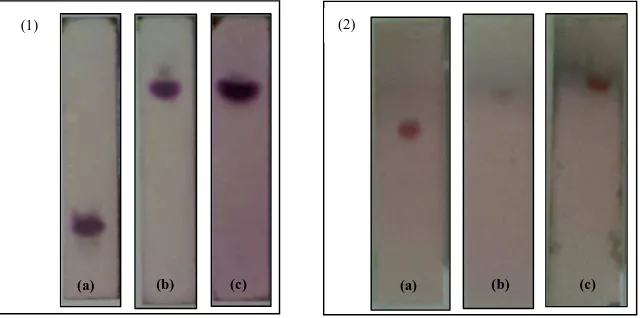Paper is presented on “International Seminar on Medicinal Chemistry and Timmerman Award 2011”, Surabaya, October 15th, 2011 1
Isolation of Iridoid Glycoside from Fraxinus griffithii Clarke
Leaves
Kartini1*, Sutarjadi2, Indah3
1
Department of Pharmaceutical Biology, Faculty of Pharmacy, University of Surabaya
2
Centre of Information & Development of Traditional Medicine, University of Surabaya
3
Under graduate student, Faculty of Pharmacy, University of Surabaya
*Corresponding author, email: [email protected] or [email protected]
Abstract. Development of new and has relatively less side-effect anti-seizure is important for pharmacist. To answer this issue, research to isolate iridoide glycoside from ethanol extract of the cortex and leaves of Fraxinus griffithii Clarke (tiken) has been conducted. Pharmacological screening test showed that those extract have anti-seizure activity on mice. It was conducted with electroshock method. Quantitative analysis with Trim-Hill reagent showed that the concentration of total iridoid of tiken leaves is higher than its cortex, 2.12% and 0.55% AE (Aucubin Equivalent), respectively. Isolation of iridoid glycosides from tiken cortex and leaves was done on an open column using silica gel as stationary phase and CHCL3-Methanol (47:3) as mobile phase. Identification of isolate from cortex (isolate X) and leaves (isolate Z) was done with three different TLC systems and used anisaldehid-H2SO4 (vanillin-H2SO4) as spray reagent. Each isolate showed a red-brown and red-purple spot. Spectrum of isolate X in methanol showed a maximum wavelength at 277.8 and 223.4 nm, whereas isolate Z at 278 and 223 nm.
Keywords: iridoid glycoside, Fraxinus griffithii, anti-seizure
INTRODUCTION
Fraxinus griffithii Clarke (“Tiken” or “orang-aring”) is a plant that grows wild on the
slopes of the mountains, like in the Besuki (Probolinggo) and Lumajang (Sutarjadi, 1980; Ali, 1988). In East Java, this plant has become famous again related with the circulation of tiken extract as adulterant for opium in 1961-1969 (Ali, 1988).
Various pharmacological studies have been conducted to investigate the efficacy of tiken extract. Tiken leaf extract has sedative and analgesic effects in mice, as well as reduce the blood pressure in dog (Ahaditomo, 1972; Ahaditomo et al., 1975). It was reported that the tiken bark extract may extend the mice sleeping time due to barbiturate (Ali, 1988). According to Ahaditomo et al. (1975), tiken leaf extract may improve the heart tone and lowering the heart rate in frog. Tiken also thought to have cardiotonic properties (Sutarjadi and Zaini, 1973; Sutarjadi, 1980; Ali, 1988). Tiken bark extract has CNS depressant effects, i.e.: mild sedation, does not cause paralysis of muscle, and does not cause sleep when tested on mice (Basori and Purwaningsih, 2004). Recent study states that tiken extracts have anti-seizure effects in mice (Purwaningsih, 2005).
Tiken bark contains a variety of compounds including ligustrosid glucoside, and glucoside of siringin and sinapaldehid. It is expected that sedation effects of tiken bark extract caused by ligustrosid glucoside (Sutarjadi, 1980). Part of tiken which has been widely researched is the bark. However, there are many things to be considered in the development of plant-based drugs (fitoterapi). One of them is the raw material should be easily obtained and processed (Depkes RI, 1985). Leaves are an abundant part of this plant, so it is important to study how its potency as an anti-seizure.
Anti-seizure activity of ethanol extract from tiken leaves will be conducted in this study. The comparative study of total iridoid concentration between leaves and stem bark extracts of tiken also will be conducted in this experiment. In order to develop anti-seizure compounds, iridoid glycoside compounds will be isolated from extracts of tiken leaf and stem bark.
METHODS
Plant materials, chemicals and Equipment
Paper is presented on “International Seminar on Medicinal Chemistry and Timmerman Award 2011”, Surabaya, October 15th, 2011 2
under indirect sunlight and pulverized using a grinding machine. Ethanol, methanol, chloroform, ethyl acetate, ether, Silica gel 60, anisaldehid, vanillin and sulfuric acid were purchased from Merck Co. (Germany); bi-distillate water (PT. Ikapharmaindo Putramas); de-mineralized water (Faculty of Pharmacy, UBAYA); CMC-Na and Phenobarbital Na. The equipment used include: electric stirrer (Janke & Kunkel IKA-Werk RE16), chromatography chamber (Camag), column chromatography, rotary evaporator (Buchi R-114), analytical balance (OHAUS), water-bath (Memmert), oven (Ecocell, MMM), UV spectrophotometer (Cintra 101), MES (Maximum electroshock seizure) and laboratory glassware.
Test animals
Test animals were male, white mice (Balb C strain, 2-3 months, 20-30 g), obtained from the Pusvetma (Pusat Veterinaria Farma), Surabaya. Prior to treatment, mice were kept in fasting ± 12 hours. Fifty test animals were grouped into five groups, each group consists of ten mice.
Preparation of extract
One kg of powdered leaves of F. griffithii was extracted by kinetic maceration (400 rpm) using 96% ethanol. The extract then evaporated at low pressure (60°C), followed by using a water-bath (60°C) until viscous extract. Thick extract then fractionated with ether and chloroform, respectively. Remaining water fraction is then concentrated and continued into the purification process.
The content of iridoid was determined according to a colorimetric method based on the Trim and
Hill reaction (Galvez at al., 2005). Briefly, 400 L of each extract was mixed with 4.0 mL
Trim-Hill reagent (acetic acid/0.2% CuSO4/HCl concentration 10:1:0.5). After the samples had been
heated (1000C, 5 min), the absorption was read at 609 nm, a blue color indicating the presence of
iridoid. The concentration of total iridoid was calculated on the basis of the standard absorption of aucubin.
Purification and identification of iridoid
Purification of residual water fraction of F. griffithii was performed using column chromatography, with silica gel as stationary phase and chloroform-methanol (47:3) as mobile phase. Then, isolates are identified by TLC and spectrophotometer (200-300 nm).
RESULT AND DISCUSSION
Anti-seizure activity
Paper is presented on “International Seminar on Medicinal Chemistry and Timmerman Award 2011”, Surabaya, October 15th, 2011 3
Table 1. Anti-seizure activity of F. griffithii leaves extract in mice
Group Mice Duration of seizure (second)
Tonic Clonic Tonic-clonic Total
C
Table 1 has shown that the duration of seizure of mice in the test groups are smaller than control.
This difference is significant (ANAVA & LSD, α = 0.05). It indicated that tiken leaf extract has
Paper is presented on “International Seminar on Medicinal Chemistry and Timmerman Award 2011”, Surabaya, October 15th, 2011 4
Total iridoids concentration
Visible Spectrum resulted from aucubin reaction and Trim-Hill reagent can be seen in Figure 1, while the concentration of iridoid total of tiken leaf extract and cortex are shown in Table 2.
Fig 1. Visible spectrum of aucubin reacted with Trim-Hill reagent.
Table 2. Total iridoid content in cortex and leaves extract of F. griffithii
Table 2 shows that the concentration of total iridoid in F. griffithii leaf extract is greater than its cortex extracts. Anti-seizure potency of F. griffthii leaves is predictably higher than its cortex because iridoid glycosides is expected responsible for such activities.
Extraction, purification and identification of iridoid glycoside
1 kg of leaf powder and 1 kg of F. griffithii cortex powder yielded 84.12 g (8.41%) and 80.468 g (8.05%) viscous extract, respectively. From the column chromatography of the residual water fraction of ethanol extract of F. griffithii leaves and cortex obtained sub-fractions that are divided into 45 vials. To view the results of purification, TLC was performed with results as shown in Figure 2.
Fig 2. TLC profile of sub-fraction from tiken leaves extract (a, b) and tiken cortex extract (c, d), with Silica gel 60 F254 as stationary phase, chloroform-MeOH (47:3) as mobile phase and
Vanillin-H2SO4 as spray reagent
Aucubin
(ppm) A
20 0.125231 40 0.244552
Replication Total iridoid (%AE) Cortex extract Leaves extract
1 0.39 2.03
2 0.41 2.06
3 0.41 2.10
4 0.43 2.15
5 0.43 2.14
6 0.43 226
X ± SD 0.41 ± 0.0002 2.12 ± 0.0059
a b c d
Paper is presented on “International Seminar on Medicinal Chemistry and Timmerman Award 2011”, Surabaya, October 15th, 2011 5 (2)
TLC profile (fig.2) shows that only one sub fraction of tiken leaves extract has shown one spot (test number 21) while the cortex extract has 3 pure sub-fractions (test number 14, 15, 16). Further, sub-fraction 21 (leaves) and 14-16 (cortex) called as X and Y isolates, respectively. Purity test results of each isolate can be seen in Figure 3.
Fig 3. TLC profile of isolate X (1) and Y (2) with Silica gel 60 F 254 as stationary phase and mobile phase CHCl3-MeOH (47:3) (a), CHCl3-MeOH (5:2) (b), and CHCl3-MeOH-Aceton
(3:1:3) using Vanillin-H2SO4 (1) and Anisaldehid-H2SO4 (2) as spray reagent
Figure 3 has shown that isolates X and Y are pure in TLC. UV spectrum of the two isolates could be seen in Figure 4.
Fig 4. Uv-vis Spectrum of isolate X (a) and Y (b) in MeOH
Figure 4 shows that isolates X and Y have two peaks, at 278; 223 nm and 223.4; 227.8 nm, respectively. Based on Sutarjadi et al. (1978), to identify iridoid compounds as ligustrosid, solution of compound in ethanol have to show maximum at wavelengths of 227 and 208 nm. Maximum at 227 nm with large enough extinction indicate the presence of iridoid group. In alkaline conditions, the maximum at 290 nm indicate the presence of phenol group, and a maximum at 227 nm is not shifted show that R' is not H but CH3. The results of the identification of isolates Y in methanol showed a maximum at a wavelength of 277.80 and 223.40 nm as shown in Figure 4 (b), so it can be said that isolates Y is the class of iridoid compounds. Under alkaline conditions after the addition of NaOH, the maximum at 292 nm, it can be concluded that the presence of phenol groups
as said by Sutarjadi et al. (1978). Isolate X is not expected as iridoid ligustrosid because it has
max 278 nm and 223 nm. Further identification (MS, NMR, and IR) is required to ensure the structure of these isolates.
(1)
(a) (b) (c) (a) (b) (c)
Paper is presented on “International Seminar on Medicinal Chemistry and Timmerman Award 2011”, Surabaya, October 15th, 2011 6 CONCLUSION
From this research can be concluded that ethanol extract of F. griffithii leaves has anti-seizure activity in mice. Ethanol extract of F. griffithii leaves contain iridoid total greater than its cortex extracts. From F. griffithii leaves and cortex extracts successfully isolated a compound which is estimated as iridoid.
ACKNOWLEDGEMENT
The authors greatly appreciate students (Rizka, Shenita & Indah) for technical assistance.
REFERENCES
Ahaditomo, 1972, Penelitian Tiken pada Susunan Syaraf Pusat Mencit, Skripsi pada Fakultas Farmasi Universitas Airlangga, Surabaya, Tidak dipublikasikan.
Ahaditomo, Suwandi A, Husin DM, 1975, Penelitian Pendahuluan Beberapa Khasiat Tiken
(Fraxinus eedenii), Simposium Tanaman Obat I, Bogor (dalam Sutarjadi, 1980, Fraxinus griffithii Clarke: Penelitian Taksonomi dan Fitokimia, Penelitian tidak dipublikasikan,
Surabaya, Fakultas Farmasi Universitas Airlangga).
Ali, M., 1988, Pengaruh Ligustrosid dari Jenis Tanaman Fraxinus griffithii Clarke terhadap Aktivitas Motor dan Konvulsi pada Mencit. Disertasi tidak diterbitkan, Surabaya, Fakultas Kedokteran Universitas Airlangga.
Basori, A., Purwaningsih, S., 2004. Identifikasi Efek Depresan SSP dari Ekstrak Fraxinus griffithii Clarke, Majalah Farmasi Airlangga, 4(1), 31-38.
Depkes RI, 1985. Obat Kelompok Fitoterapi. Depkes RI, Jakarta.
Galvez, M., Martin-Cordero, C., Houghton, P.J., Ayuso, M.A., 2005, Antioxidant Activity of Methanol Extracts Obtained from Plantago species, Journal of Agricultural and Food
Chemistry, 53, 1927-1933.
Purwaningsih, S., 2005, Identifikasi Efek Depresan SSP, Efek Antiseizure, Mekanisme Antiseizure, serta Efek Neurotoksisitas dari Ekstrak Fraxinus griffithii Clarke (Pohon Orang
Aring), Faculty of Pharmacy Airlangga University, (online),
(http://www.adln.lib.unair/go.php?id=jiptunair-gdl-res-2005purwanings 1322&PHPSESSID=633b diakses 8 Agustus 2010)
Sutarjadi, 1980, Penelitian Taksonomi dan Fitokimia ”Fraxinus griffithii Clarke”, Disertasi tidak diterbitkan, Surabaya, Fakultas Farmasi Universitas Airlangga, 3-5.


